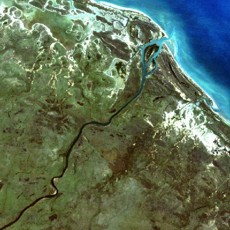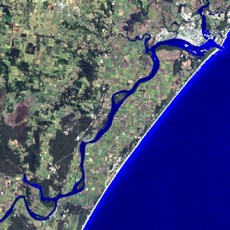Also known as: riverine estuary
Conceptual model diagrams of wave-dominated deltas
 Physical Characteristics
Physical Characteristics
Sedimentary Environments (Habitats)
Hydrology
Sediment Transport
Nitrogen Dynamics
Key features of wave-dominated deltas
- Habitats supported are variable, generally mostly brackish subtidal, intertidal and supratidal habitats.
- Narrow entrance restricts marine flushing; only a small proportion of the water volume is exchanged each tide.
- River flow typically high, and flooding commonly expels marine water and flushes material from the delta.
- Turbidity, in terms of suspended sediment, is highly dependant on catchment inflow, however is naturally low except during extreme fluvial runoff events.
- Sediment (and associated contaminants) are mostly expelled into the coastal ocean.
- Short residence time (e.g. efficient flushing) results in little processing or trapping of nutrients.
- ‘Mature’ in terms of evolution. Tend to be stable in terms of morphology (given stable sea level).
Geomorphology
Wave-dominated deltas are comprised of a river that is directly connected to the sea via a channel(s) that is usually flanked by low-lying vegetated floodplain and swampy areas. Entrances of wave-dominated deltas are relatively narrow due to constriction by a barrier (or sandbar) and, due to the relatively high river influence throughout the system, are rarely closed off from the ocean.
In Australia, wave-dominated deltas are most abundant on the north-east, south-east, and south-west coasts, and represent ‘mature’ forms of wave-dominated estuaries, having been largely infilled by sediment from terrigenous and marine sources (Roy et al., 2001, Roy, 1993). Therefore, they do not necessarily display the morphology of the ancestral bedrock valley in which they have developed (Boyd et al., 1992, Dalrymple et al., 1992, Hinwood et al., 1999).
Australia’s high relative aridity, low relief, and geological antiquity has resulted in a distinct lack of large deltas (by world standards) and associated continental river systems. Total discharge of terrigenous material is small by world standards (Fryirs et al., 2001). Many wave-dominated deltas in Australia do not contain large coastal protuberances, due to this lack of sediment supply, in combination with shoreline erosion and sediment redistribution by wave energy (Heap et al., In Press).



Figure 1. Examples of wave-dominated deltas: Robinson River (NT), Richmond River (NSW), Gascoyne River (WA).
Evolution
During the later stages of deltaic evolution (or sediment infilling), the connectivity between the river channel and tidal inlet increases. This results in more efficient delivery of fluvial sediment to the ocean, and the bypassing of remnant central basin features (i.e. ‘cut-off embayments’), which slowly infill and become swamp areas. As a consequence, the gross morphology (and thus habitat distribution and abundance) of wave-dominated deltas is relatively stable, and may persist over long periods of time with little change (Heap et al., In Press). In areas with increased sediment supply, such bypassing to the coast can allow the barrier to prograde, which may result in the formation of a coastal protuberance adjacent to the mouth of the river (Roy et al., 1980). Large magnitude river floods may also cause temporary delta-front progradation, however wave erosion and currents tend to disperse this sediment (Cooper, 1993, Hume et al., 1993).
Habitats and ecology
Wave-dominated deltas typically support ‘euryhaline’ estuarine species, as well as transient visitors from full marine environments, depending on river flow conditions (Roy et al., 2001). Intertidal habitats are limited in extent, and are restricted mainly to the barrier and flood tidal delta (Cooper 1993). Wave-dominated deltas typically support high-energy sandy beaches and channels, intertidal mudflats, saltmarshes, and mangroves (Alongi et al., 1999). Typically, sandy channel margins support various macrophytes such as seagrasses (Abal et al., 1996).


